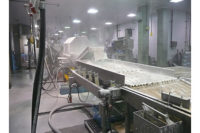Special Report
Worker safety: How to protect employee health
Preventing Campylobacter infection among employees in a poultry-processing plant.






Campylobacter is one of the most common bacterial causes of gastrointestinal infection in the United States, with an estimated 2.4 million cases of Campylobacter infection per year. These bacteria live in the gastrointestinal tracts of poultry, and humans are typically infected through eating undercooked poultry or handling the raw meat. As little as one drop of raw chicken juice is enough to cause Campylobacter infection.
Symptoms of the illness typically begin between two and five days after exposure and usually include diarrhea (which may be bloody), cramping, abdominal pain, fever, nausea and vomiting. The Food Safety and Inspection Service (FSIS) of the U.S. Department of Agriculture (USDA) has compliance guidelines for comprehensive control of Campylobacter in poultry-processing plants, but because these recommendations are focused on consumer food safety rather than worker protection, additional measures are necessary to protect the health of employees.
In 2011, management representatives of a poultry-processing plant in Virginia contacted the National Institute for Occupational Safety and Health (NIOSH), part of the Centers for Disease Control and Prevention (CDC), to perform a health-hazard evaluation at the plant. A number of employees had been diagnosed with Campylobacter infections. Because the plant had experienced a similar outbreak previously, the Virginia Department of Health suggested the plant request an evaluation into the causes of and possible solutions to the problem.
The plant employed approximately 1,000 employees, 24 to 35 of whom at any one time were residents of two diversion centers, residential work assignment programs run by the Virginia Department of Corrections. The plant processed about 300,000 to 350,000 birds per day.
In order to assess exposures, infections and controls, we observed work practices and processes, and workplace conditions at the plant. We interviewed employees, reviewed medical and employment records, and reviewed health and safety-related policies and training manuals.
We identified 29 cases of laboratory-diagnosed Campylobacter infection among plant employees through records from the health and corrections departments between January 2008 and May 2011. We also learned about the plant’s ventilation system and environmental sampling programs for chlorine and Campylobacter. Details of the evaluation can be found in the Health Hazard Evaluation (HHE) report at http://www.cdc.gov/niosh/hhe/reports/pdfs/2011-0058-3157.pdf.
Based on our observations, examination of medical records and employee interviews, we determined a health hazard from Campylobacter existed in this plant. We found that approximately 15 percent of more than 3,000 encounters at the plant’s medical office from January 2010 through September 2011 were related to gastrointestinal symptoms. Almost one-third of the interviewed employees reported they had been ill with gastrointestinal symptoms in the five-month period prior to the interview, and fewer than half of these employees had reported their illness to the plant.
The structure of the plant’s sick-leave policy and lack of paid sick leave may have contributed to underreporting of Campylobacter and other illnesses and could explain why residents of the diversion centers, who had easier access to health care, were diagnosed with the illness more frequently than other employees. Most of the laboratory-diagnosed cases were in employees working in the live hang area, those who were also residents of a diversion center, and those who had worked at the plant for less than a month before becoming ill.
There were several factors that may have contributed to more infections being found among employees in the live hang area. Transport cages are known to be contaminated with Campylobacter, as are feathers, skin, crops, cloacae and feces of the birds. Because commercial broiler flocks live in high-density housing, Campylobacter colonization rates may be as high as 90 percent to 100 percent of the chickens. The USDA notes that high bacterial loads on live birds can undermine protective measures within a processing plant.
Employees in this area worked on both sides of the conveyor that held the chickens before shackling. Twenty air-supply vents were located above the employees’ heads and were positioned to blow air toward the conveyor [see Figure 1 on page 39]. This arrangement had the potential to aerosolize or spread contamination in this area.
Additionally, there were two water coolers in the live hang area, from which employees were permitted to get drinks in disposable cups [see Figure 2 on page 40]. Employees obtained water from these coolers without washing their hands or removing personal protective equipment (PPE), further increasing the potential for exposure.
In general, hand-washing technique and PPE use and removal were inconsistent throughout the plant. When going on break, some employees washed their protective aprons and gloves with soap before removing them (aprons were not permitted in the break room), but did not wash their hands. Others washed their hands, then removed and rinsed their aprons without re-washing their hands afterward.
Although safety glasses were required PPE for live hangers, not all of the employees wore them. The majority of employees reported receiving written copies of plant policies or instruction on PPE use upon hire, but they did not receive refresher instruction. Among interviewed employees, 87 percent reported always washing before beginning work and 92 percent after finishing work; 85 percent before a break and 79 percent after a break.
In addition, the wash stations themselves were sources of potential cross-contamination. While most of the sinks were hands-free, most of the soap dispensers and waste receptacles required employees to touch them in order to use them.
In order to decrease the risks of infection and create a healthier workplace, we recommended changes at the plant based on an approach known as the hierarchy of controls, which groups actions based on their likely effectiveness, from most to least effective. Because those best qualified to evaluate the feasibility of recommendations and to determine priorities are those involved in the work, we encouraged the processing plant to use a labor-management health and safety committee or working group to develop an action plan based on these recommendations.
Engineering controls reduce exposure by removing the hazardous substance from the worker’s environment or placing a barrier between the hazard and the employee. We recommended the following engineering controls:
- Install hands-free soap dispensers and waste receptacles at all hand-washing stations.
- Move the water coolers from the live hang area to another location, and consider providing hands-free water dispensers.
- Thoroughly sanitize and dry transport cages to reduce bacterial burden.
- Redirect air from the supply vents in the live hang area to flow vertically from above employees’ heads downward to the floor, away from the conveyor. This may help both to reduce the amount of aerosolized contaminants from the conveyor and to create an air shower to reduce inhalation of those contaminants. Alternatively, reposition the supply ducts away from the conveyor and the employees.
- Consult a ventilation engineer familiar with poultry-processing plants to design local exhaust ventilation near the conveyor, to capture contaminants near the birds.
- Wet down the chickens before shackling to reduce airborne contaminants.
Administrative controls are practices and policies that prevent or reduce hazardous exposures. These only work if employers commit to them and employees follow them, and they require regular monitoring and enforcement. Recommended administrative controls are:
- Provide detailed training to all employees on how and when to wash their hands. This should be done upon hire and at least annually thereafter. Consider placing signs that illustrate proper technique above all wash stations (see the Appendix of the HHE for examples of such signs: http://www.cdc.gov/niosh/hhe/reports/pdfs/2011-0058-3157.pdf). Supervisors and managers should provide retraining whenever they observe incorrect technique.
- Offer all training to employees in both English and Spanish (the native languages of employees at this facility).
- Train the plant’s medical staff to recognize and ask about illness that includes diarrhea. Staff should encourage ill employees to stay home to make arrangements for additional health care when necessary. The plant’s medical staff should work closely with the medical staff of the diversion centers to be certain all cases of diarrheal illness are appropriately reported.
- Change the plant’s sick leave policy so employees do not work when ill. Consider offering paid sick leave. Employees who work while ill with Campylobacter can spread the illness to others.
- Explore on-farm strategies with growers and veterinarians to reduce the rates of poultry contamination.
The final method in the hierarchy of controls is the use of PPE. PPE is the least effective method of controlling exposure and should not be used as the only control method. To get the maximum benefit from PPE, the right equipment must be used for each type of exposure, and employees need to be trained and thoroughly committed to its use. We recommend the following:
- Provide detailed training to all employees on how to correctly put on, wear, remove, clean and change out each type of PPE required or recommended for their job. This should be done upon hire, at least annually after hire, and whenever changes make previous training outdated, as well as any time employees are seen to use PPE incorrectly.
- Provide PPE at no cost to employees as defined in OSHA PPE general requirements standard in the Code of Federal Regulations [29 CFR 1910.132].
- Educate line leaders, supervisors and managers about the required PPE for their areas. Encourage them to enforce PPE use among employees.
- Consider requiring face shields in the live hang area rather than goggles or safety glasses. Face shields not only help protect eyes, but help prevent oral exposure as well.
We returned in November 2013 as part of a follow-up evaluation to learn about changes made at the plant. The plant had implemented most of the recommendations detailed in our report, and health department surveillance records showed that the number of cases of laboratory-confirmed Campylobacter infection among plant employees had decreased substantially.
1 CDC [2011b]. Vital signs: incidence and trends of infection with pathogens transmitted commonly through food — Foodborne Diseases Active Surveillance Network, 10 U.S. Sites, 1996–2010. MMWR 60(22):749–755
11 USDA [2010]. Compliance guidelines for controlling Salmonella and Campylobacterin poultry, 3rd ed. [http://www.fsis.usda.gov/PDF/Compliance_Guide_Controling_Salmonella_Campylobacter_Poultry_0510.pdf]. Date accessed: December 2011.
Looking for a reprint of this article?
From high-res PDFs to custom plaques, order your copy today!










